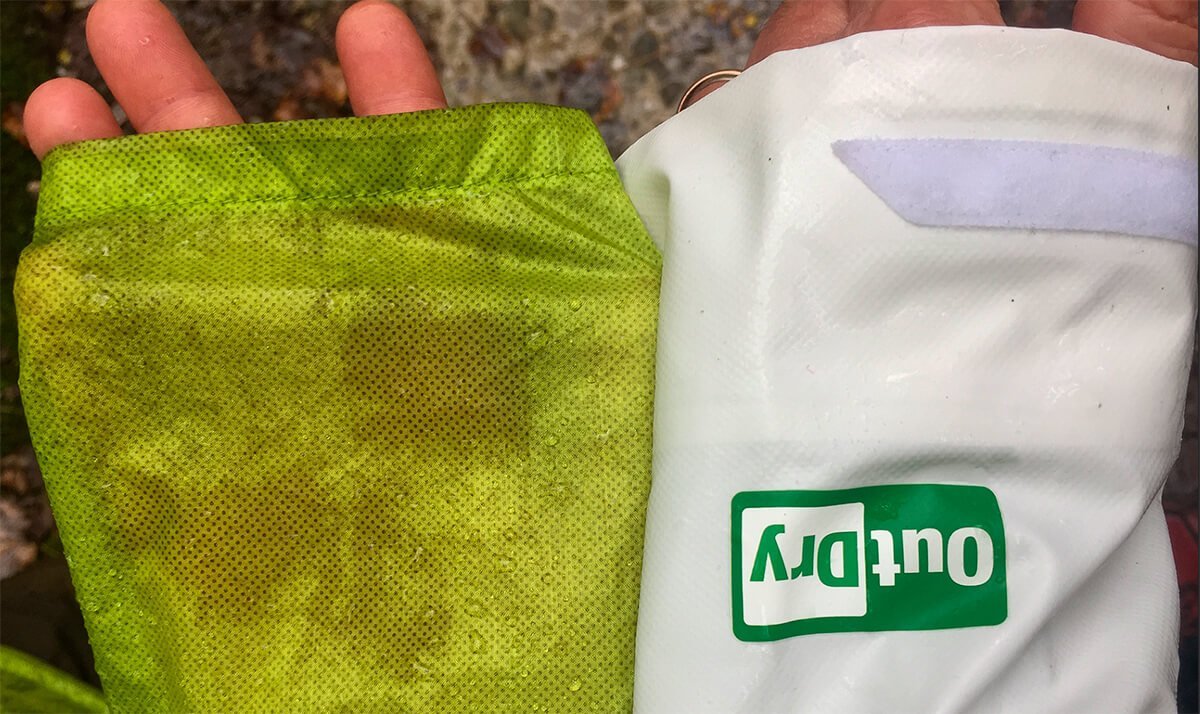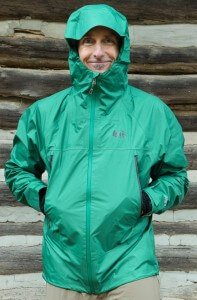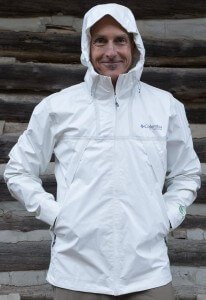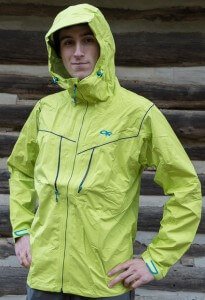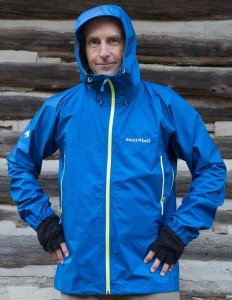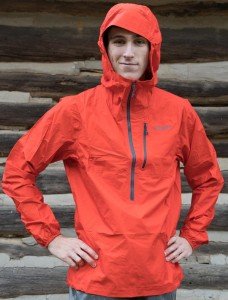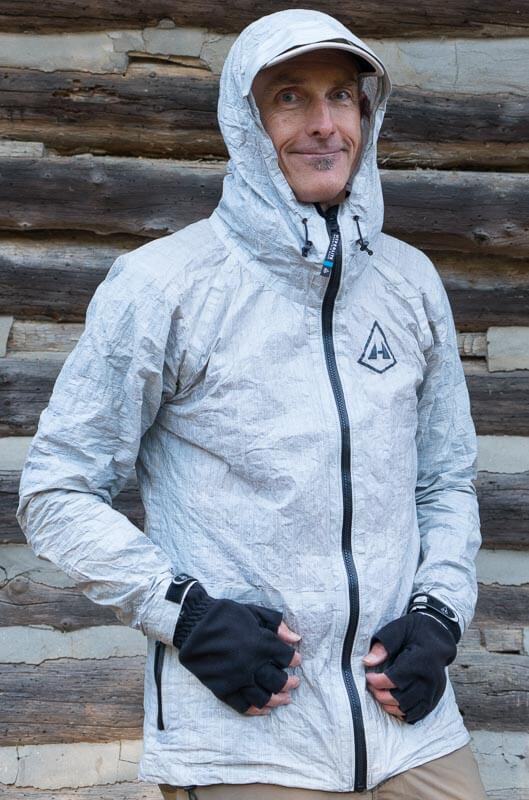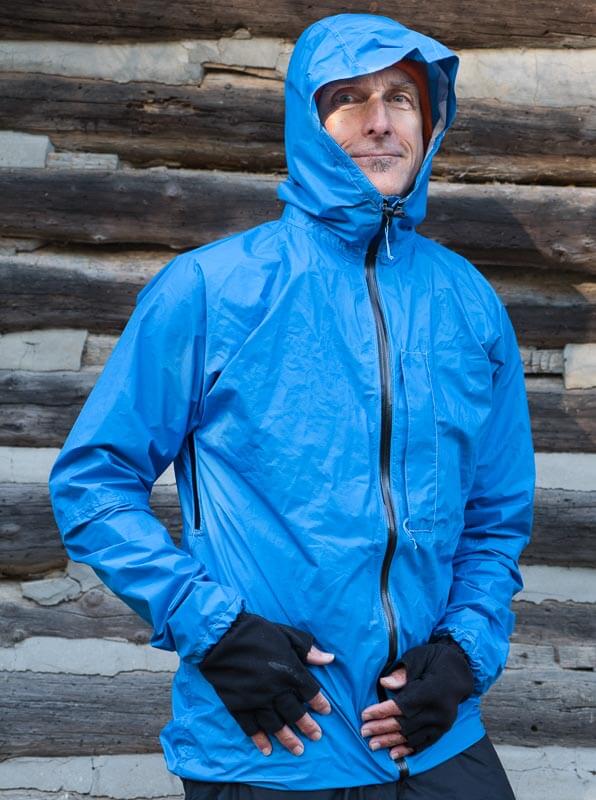A SuperStove combines a pressure regulated, wind resistant, high BTU burner with a heat exchanger pot for max efficiency in wind and cold.
This article explains everything you need to know about Challenge ULTRA™, a relatively new-to-market, best-in-class outdoor fabric, and what makes it the highest performing textile for backpacks.
Smartphones like an iPhone or Samsung Galaxy outperform a conventional GPS in almost every way. This post has all the information you need to use your smartphone as the best backpacking GPS, including getting up to 7+ days of battery life without recharging. Best of all, you can do this for less than $20!
Ever wanted to go faster on the trails? Now you might be able to with the new technology of Hi-Tech Hiking Shoes!
Whether you are a beginning or experienced backpacker or hiker, Adventure Alan is about helping you become a better, more efficient & happier backpacker. To this I bring 50 years experience of backpacking all over the world (20 years ultralight backpacking), professional guiding in extreme places like Alaska.
This post takes the BS & mystery out of finding the right camera. A camera that meets YOUR needs & YOUR budget. And you don’t need an expensive camera to take superb backpacking photos. Some of the best lightweight backpacking and hiking cameras cost far less than you think. You might already own one!
Rain jacket “durability” is a complex topic not well understood by most people. This post debunks some durability myths and clearly lays out what to look for in a durable rain jacket. Finally, we list some of the very best durable rain jackets on the market that are also light!
If you can’t wait, jump to see our Best Durable Rain Jackets here. Or the new complete list of Best Ultralight Rain Jackets for Hiking and Backpacking.
This is part 1 of a series on Rain Jackets:
- Rain Jacket Durability 101 – How to Select the Best Durable Rain Jacket
- NEW! Best Ultralight Rain Jackets for Hiking and Backpacking
This includes a section Rain Jacket Breathability 101 or why waterproof-breathable rain jackets get an unfair bad rap!
What is Rain Jacket Durability?
In brief, rain jacket durability is a complex topic that includes the jacket remaining waterproof while continuing to breathe (vent body moisture), the shell fabric not ripping, seams not failing, and zippers, elastic adjusters, velcro etc. continuing to work without massive cleaning and maintenance.
| NOTE: There are many good reasons why you might not buy the most durable rain jacket! Case in point, is the 8 oz, 2.5 layer jacket above, my first choice for so many trips that it finally wore out. See more here… |
The 12 oz REI Co-op Rhyolite with its 3-layer eVENT fabric is durable AND Light. At half the price of competitor’s jackets, it’s a great value!
The Three Elements of Rain Jacket Durability
A. Outer shell fabric durability
The ability of the rainwear’s exterior fabric to:
- Resist tearing, punctures and abrasion damage
- Maintain its water shedding & breathability—usually with a durable, water repellent finish DWR
Note: outer shell fabric “wet out,” the breakdown of this water shedding property, does not completely stop all breathability as is popularly believed. See more below.
B. Inner waterproof/breathable (WPB) membrane durability
The ability of the shell’s inner WPB lining to maintain waterproofness AND breathability:
- The WPB membrane should remain physically intact under the wear and tear of garment use (not so easy in regular use with a backpack!).
- In particular the WPB membrane should not delaminate from the outer shell, develop cracks, etc. In this case, 3-layer construction jackets are likely more durable. That’s because their inner fabric liner protects the more delicate WPB membrane vs. the unprotected membrane of 2.5 layer jackets.
- The WPB membrane should not foul with body oils, dirt, detergent residues or other materials which will cause the WPB membrane to leak.
C. Hardware failures
- Zippers that jam, no longer mate at the bottom, or start auto-separating in the field
- Elastic adjusters on hoods, cuffs and hems of jackets. Velcro that looses its stick, adjusters/buckles that break or slip, etc.
So What Fails Most Often?
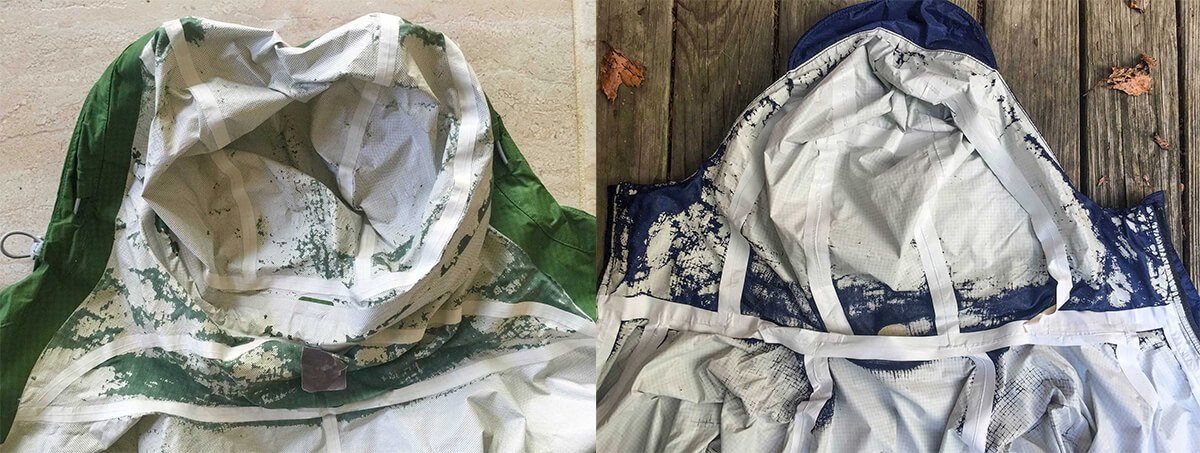
[Two high quality 2.5 layer jackets from big name outdoor gear companies] In my experience, membrane delamination like this in the neck and upper shoulders is the most common way that rainwear permanently fails. While this happens faster to the unprotected WPB membrane of 2.5-layer jackets like these — if you wear a 3-layer jacket long enough it too will eventually delaminate and leak. And backpackers beware: wearing a pack dramatically speeds up this delimitation process for both 2.5 and 3-layer jackets!
1) Waterproof Breathable Membrane Delamination
As the pictures above show, WPB membrane failure is likely the first and most common, non-fixable way rain jackets fail (leak). And note that while the examples are dramatic, many small cracks, punctures, and delaminations are not obvious but will still cause your jacket to leak. This is true for 2.5 and 3-layer jackets, although 3-layer rain jackets usually last longer. This is one reason why the outdoor industry still makes a big deal about 2.5 vs 3-layer construction.
| Note: Many outdoor companies like Patagonia, REI and Outdoor Research, offer good product warranties that cover zipper failures, membrane delamination, etc. This will protect your jacket as a long term investment. But if your jacket fails in the field you may have to suffer through wet until you get home and can ship it back for repair or replacement. |
On the left is a traditional fabric surface treated with a DWR that has already started to fail (wet out). Large wetted out areas will reduce the breathability of a rain jacket. In comparison, on the right is a newer, non-chemical water shedding fabric technology, Columbia’s naturally hydrophobic Columbia OutDry Ex Eco Tech fabric continues to bead and shed water.
2) “Wet Out” (DWR failure) – Outer Shell no Longer Beading/Shedding Water
Wet out is another common “failure,” altho it can be fixed. Wet out happens when the durable, water repellent finish DWR no longer beads up and sheds water. The most common reason for this is the DWR finish (a chemical) wearing off after many garment washings, and/or the surface getting fouled with dirt and other compounds. While this doesn’t cause the rain jacket to leak, it does likely slow down the breathability of the jacket (see more below). This makes it easer to sweat out the inside of the jacket if you are working hard. Your DWR can be refreshed by washing the jacket and treating it with a DWR restoring wash compound and/or spray. E.g. some of these form Nikwax.
Note: While, some newer fabrics like Columbia OutDry Ex Eco are inherently hydrophobic and don’t need a DWR. You will still need to keep the fabric free of dirt for best water shedding.
Myth: A Wetted Out Rain Jacket Doesn’t BreatheIt’s a myth rainwear stops breathing once it wets out. This is according to interviews I had with 1) Jeff Mergy, the Director of the Innovation Team at Columbia Sportswear (among other things tech. guy for OutDry Ex Eco Fabric and 2) Dr. Fred Wilson PhD a long term industry scientist who worked for both GORE and eVENT on WPB fabrics. In an interview I had with Jeff Mergy, he stated that WPB membranes are still breathable when outer shell is wetted out but not as breathable. It is still not clearly understood how less breathable but Jeff believes it is significant. BUT he said that part of what consumers believe is “not-breathable” is often the clammy next skin feel of conventional WPB jackets. Columbia OutDry Ex Eco helps with this by having an actual wicking fabric that feels far more comfortable next to the skin. Even when the outer shell is wetted out. [Note: other 3-layer technologies with a fabric liner should have a similar non-clammy feel.] |
3) Fouled WPB Membranes Can Leak
Body oils, dirt, and other compounds can contaminate the inner WPB membrane and cause it to leak. This is another non-permanent failure that can generally be fixed by properly washing your jacket. Nonetheless this is a problem in the field as it can’t be easily fixed until you get home. 3-layer jackets are less prone to membrane contamination since they have a fabric liner that keeps them away from your skin, dirt, oils and other sources of contamination.
From ‘B’ and ‘C’ it should be clear that keeping your rainwear clean, and refreshing the DWR are easy ways to improve the long-term breathability of an waterproofness of your rain jacket. So use products like these form Nikwax.
4) Hardware Failures
Another fairly common failure are front zippers that jam, no longer mate at the bottom, or start auto-separating in the field. In my experience zipper problems are second only to membrane delaminations for “non-fixable” failures. It is why I prefer beefier toothed zippers (vs. coil) on my rain jackets, or even a 1/2 zip rain jacket that eliminates the always risky mating of the zipper at the hem.
5) Ripping, Tearing and Puncturing the Jacket Shell Fabric
Finally, what rarely fails (at least in my 20+ years of using modern rain jackets) is the actual shell fabric of the rain jacket. I’ve used a large number very thin jackets over the years and they have rarely torn, ripped, punctured or had a seam fail. Generally, something else gets them first. (But I do avoid bushwhacking in sub 7 ounce rain jackets if at all possible.) Note that torn, ripped, punctured jackets are rarely covered under any warrantee, so the durability of a rain jacket’s outer shell fabric is a serious consideration if you think you might abuse your jacket.
The Best Durable Rain Jackets
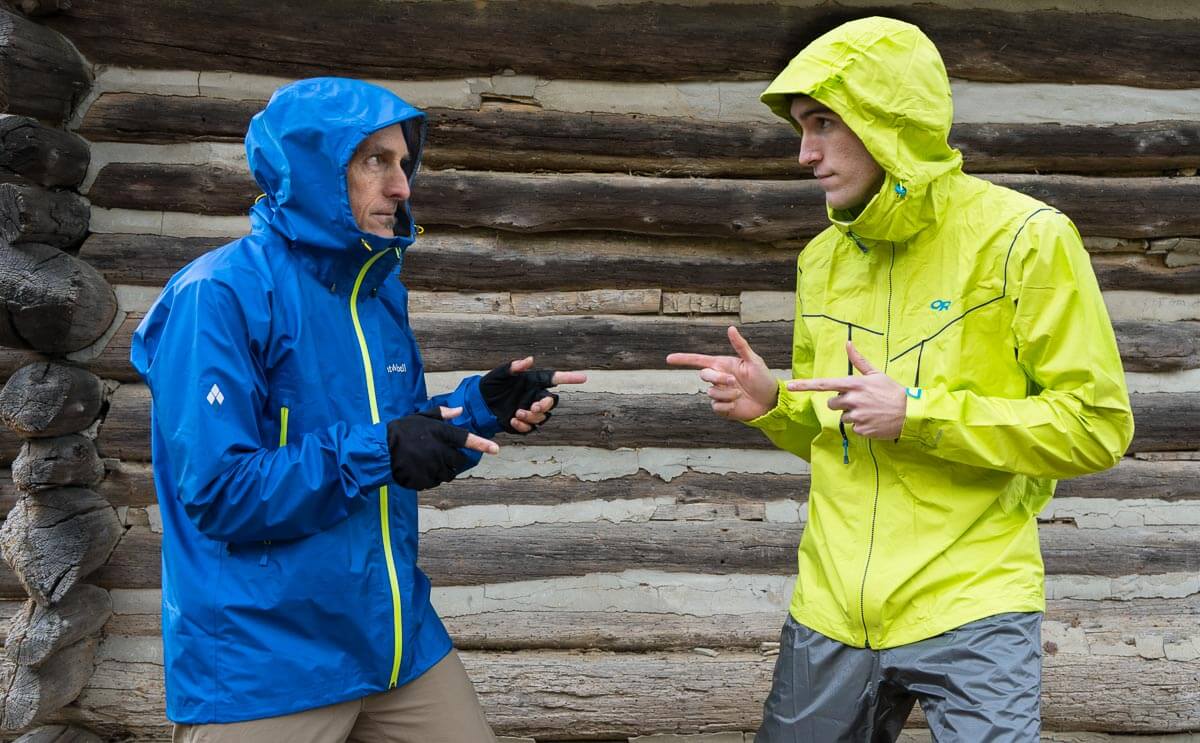
Two of the very best durable rain jackets. (Green – Right) Outdoor Research Realm with its extremely breathable, tough, semi-stretch AscentShell 3-Layer fabric. (Blue – Left) Montbell Storm Cruiser which manages a full feature set including big pit zips at only 10 oz. Both have chest pockets well above a pack’s hipbelt.
Not long ago, a getting a durable rain jacket meant getting heavy bulky jacket that cost and arm and a leg. Now you can get a tough and durable rain jacket that is under 12 ounces and possibly as light as 6 – 8 ounces. And some cost less than you’d think!
The following are our picks for the Best Durable but still Lightweight Rain Jackets for Backpacking. The cutoff weight for inclusion is approximately 12 ounces. We believe that for this weight you can get sufficient durability, features, waterproofness and breathability for all activities short of severe bushwhacking and intense alpine climbing (and even then… ). And while we do not exclude running or climbing/mountaineering jackets they also need to be well suited to backpacking (and some are).
Note that many mainstream outdoor apparel brand offer “extremely durable” jackets. These jackets often use GORE-TEX pro with 50-70 denier fabric (or similar). They weigh 16-24 ounces and cost ~ $300-500. These have limited application in sports or professions other than hiking. We strongly believe they are far too heavy for hiking, backpacking or even lightweight mountaineering or climbing.
REI Co-op Rhyolite
WEIGHT: 12 oz – $189
At at almost 1/2 the price of competitor’s jackets the Rhyolite is a great value!
TECH: 3-layer eVent DValpine™ fabric (20,000 g/m2/hr)
FEATURES: The REI Co-op Rhyolite is a solid three layer jacket at a great price! It has two well placed chest pockets and adjustable hem, cuffs and hood. REI made some good design choices with this jacket: the pockets are high enough to use when wearing hip straps and it has mesh pocket linings creating two large and effective chest vents (which we prefer over pit-zips). Additionally, the Rhyolite’s seam-free shoulder design is good when wearing a pack and should increase durability in this critical area. If you’re planning on buying this jacket, note that the hem comes up just a little short in the back, and the fabric is a bit on the stiff side (it didn’t bother us).
BEST FOR: Hikers and backpackers looking for a great value in rain protection with good breathability and great ventilation that can endure significant wear and tear. And it has the REI warranty! Note: the jacket uses the more waterproof/but moderate breathability 3-layer eVent DValpine™ fabric (20,000 g/m2/hr) vs. the more highly breathable DVstorm fabric (30,000 g/m2/hr).
Columbia OutDry Ex Eco Tech Shell Rain Jacket – M’s & W’s
WEIGHT: 12.1 oz – $199
TECH: OutDry Ex Eco fabric (“1-Layer” is our term, not the manufacturer’s, since the shell fabric & membrane are one in the same!)
FEATURES: An unusual entry, the OutDry Extreme Eco uses newly developed eco-friendly, “1-layer” technology to make a mid-price, full featured, lightweight rain jacket with elastic drawcord hood (and hood velcro), velcro adjustable cuff, drawcord adjustable elastic hem, and two mesh chest pockets (great for ventilation). From our use the OutDry Ex Eco fabric is waterproof, breathable, and quite tough. And the OutDry technologies inherent water repellence prevents wet out without using traditional PFC-based DWRs. The jacket has a roomy fit for layering and nice length in the back for covering your tail. Some have criticized the Eco for keeping in the heat, but we have not found that to be the case.
Note that compared to the other 3-layer jackets in this category, the fabric in these jackets feels odd, like your first rubber rain jacket in grade school. This may be off-putting to some. But we didn’t find it impaired its performance. And the all-white color while eco may not be some people’s ideal fashion statement for the trail.
BEST FOR: Someone looking for an extremely durable jacket for frequent use that has long term waterproofness and breathability and water shedding (without need to refresh a DWR). This jacket might well survive the longest when worn continually with a backpack.
Outdoor Research Realm
WEIGHT: 10.9 oz – $279
Possibly the best all-around jacket in this group and at a reasonable price.
TECH: AscentShell 3-Layer, 100% nylon 20 D mechanical stretch ripstop face with 100% Polyester 12 D backer (30,000 g/m2/24h)
FEATURES: The Outdoor Research Realm is a close competitor with the Montbell Storm Cruiser — they’re close in price, weight, feature set. What makes the Realm unique is its high breathability (30,000 g/m2/24h!) AscentShell fabric which also has stretch and a super nice feel. The Realm has two double pockets in the chest (one mesh, one waterproof with a subpocket for an iPhone in the mesh pocket), dual drawcord hood, tough toothed zipper, huge hood, velcro cuffs, and stiffened brimmed hood. The Realm also has great range of motion in the shoulder area making it well suited for climbing as well as backpacking .
BEST FOR: Anyone looking for tough, highly breathable, full-featured rain that works equally well for hiking, backpacking or climbing. Note that the Realm does not have pit-zips, altho its fabric breathability makes these less essential.
Montbell Storm Cruiser
WEIGHT: 10.0oz – $289
This is the #1 selling rain Jacket in Japan, a country crazy about hiking and getting outdoors.
TECH: 3-layer GORE C-KNIT Backer Technology 20-denier Ballistic rip stop nylon
FEATURES: The Montbell Storm Cruiser is a full-featured, durable jacket that competes with the Outdoor Research Realm. The Storm Cruiser has all the bells and whistles while remaining at 10 oz! Drawcord adjustable hem, velcro adjustable elastic cuffs, big pit zips, two big waterproof chest pockets (above that pesky hip belt), a good-sized coil zipper and a three way adjustable hood (it’s quite deep). For venting the Storm Cruiser has two large pit-zips vs. the Realm’s single mesh lined chest pocket. This may be more to some people’s liking.
BEST FOR: Anyone looking for tough, breathable, well designed rain jacket that has pretty much every feature, including large pit-zips! Note: This jacket is only available directly from Montbell.
Patagonia M10 Anorak
WEIGHT: 8 oz
Note: The Patagonia M10 Anorak is the only jacket here that fits in both this 3-layer Durable Category and the ExtremeLight Category below. Quite an achievement if you can deal with the 1/2 zipper and minimal feature set! And it does have a nice chest pocket!
TECH: 3-layer, 2-oz 12-denier 100% nylon ripstop with a WPB barrier and a DWR finish
FEATURES: The M10 Anorak has a huge hood, deep chest zip and Napoleon pocket. The zip on the front contributes to the durability of the jacket (much lower risk of zipper wear and separation) and the reduced feature set leaves less to break while still allowing for full functionality. The jacket does have a snug fit — we had to size up to fit the jacket comfortably. But the Anorak is a standout pick in our list for anyone looking for durability that doesn’t weigh you down. Additionally, the Anorak further improves durability by using tough “welded seams” and moving seams away from the back, neck, and shoulder area (places where the jacket wears the quickest).
BEST FOR: The M10 Anorak is an excellent choice for someone looking for a long lasting fabric and feature set jacket that is incredibly light. Intended for athletes, the Anorak’s slim fit is extremely useful for runners climbers and others not looking for much insulation beneath a rain jacket. Given that, if you want to layer with the Anorak, you should consider sizing up.
ExtremeLight Rain Jackets that are a durable in their own way
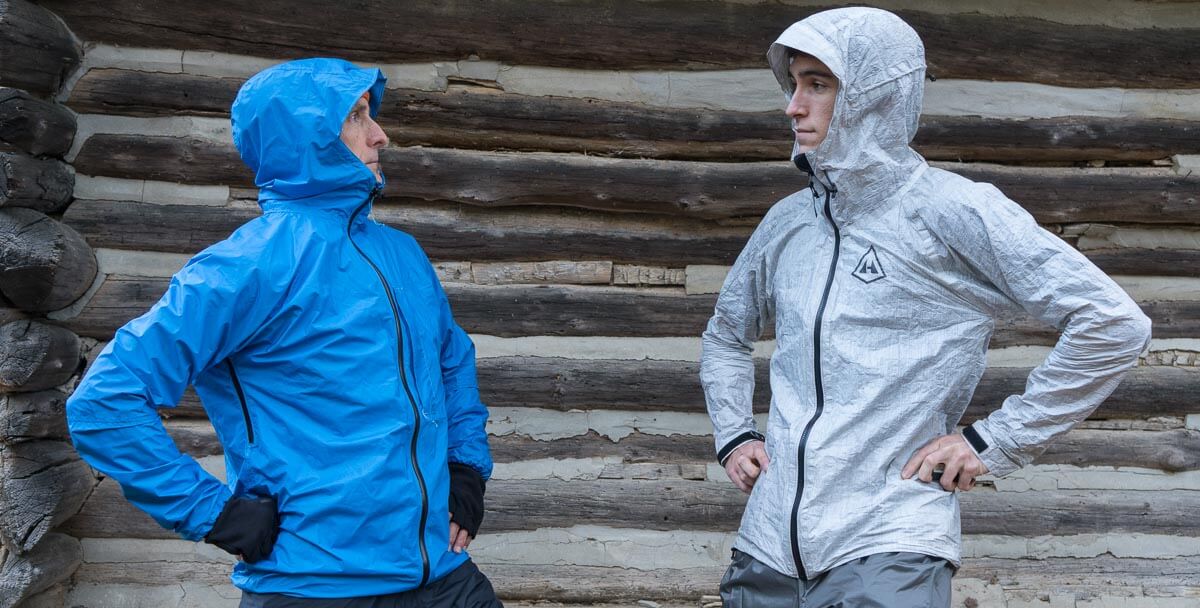
(R) Hyperlite Mountain Gear: THE SHELL jacket has unusually durable fabric and many full-sized features for its 5.8 oz weight. (L) Zpacks Vertice jacket has crazy high 56,000+ g/m2/24hr breathability!, 3-layer fabric and yet still weighs ~6 oz with a full feature set including pit-zips.
Hyperlite Mountain Gear: THE SHELL
5.8 oz – $450
Note: Hyperlite Mountain Gear: THE SHELL jacket is included for its unusually durable shell fabric, eVENT breathability and many full-sized features for its weight.
TECH: 2-layer, strong and super-breathable (32,000 g/m2/24hr) eVent | DCF-WPB fabric (formerly Cuben) with Dyneema® and eVent® materials technology
FEATURES: This is both the lightest and most expensive jacket of the group. Staying true to the HMG motto “less weight more options,” THE SHELL is extremely roomy, super-breathable (Breathability Rating: 32,000 gm2/24hr), and fully featured. It’s amazing that a sub 6 oz jacket can have an easy to operate, beefy, toothed waterproof zipper; a large, full-featured hood, and full-sized cuff closures. The Dyneema® Composite Fabrics (formerly Cuben Fiber) shell fabric is strong and compressible. The only thing to keep in mind is that the 2-layer eVent membrane is not protected with a fabric backing like more durable 3-layer jackets. Full review is here…
BEST FOR: Ultralighters looking for the very lightest jacket but with a tough outer shell fabric — and don’t mind spending significant $. It’s better for less frequent rain vs. week-after-week wear with a heavy backpack on, e.g. wet climates like Pacific NW.
Zpacks Vertice
WEIGHT: 6.2 oz – $300
Note: Zpacks Vertice jacket is included because of of its 56,000+ g/m2/24hr breathability!, 3-layer fabric (membrane durability) but still weighing around 6 oz and full-featured with pit-zips.
TECH: 3-Layer “Ventum-WPB” fabric. crazy 56,000+ g/m2/24hr breathability!, Tricot lining, a waterproof, vapor permeable membrane, & 7 denier ripstop nylon on the exterior.
FEATURES: The Zpacks Vertice is nearly twice as breathable as the next most breathable jackets in this guide—56,000 vs 32,000. Its 3-layer construction has a fabric liner to protect the WP/B membrane. It’s also the most fully featured jacket in this group, with a large dual adjustment hood with stiffened brim, pit-zips, adjustable cuffs, a large chest pocket, & long protective hem.
BEST FOR: Ultralighters looking for the lightest jacket that is super breathable, fully featured including pit-zips, and with 3-layer construction to protect the WP/B membrane. Note that this has the thinnest shell fabric of any jacket (7 denier ripstop nylon). That being said, the fabric does not seem to be unduly delicate. Adjustment hardware is also among the smallest and lightest in this group making it harder to manipulate than larger hardware.
Conclusion
If you will frequently wear your rain jacket with a pack on and/or use it bushwhacking etc. one of the durable rain jackets above is likely your best choice. Just to be clear, there is no perfect rain jacket. And there are implications for choosing the most durable rain jacket. That is, a rain jacket that scores highly on all of the durability features above will be expensive to very expensive and likely weigh 11 to 12 oz. This is about double the weight of the lightest rain jackets. And it is likely 2 to 4 times the cost of an excellent value rain jacket like the Marmot Precip.
Why might you get a less durable rain jacket?
Alternatively, while many very light rain jackets have thinner less durable shell fabric and/or thinner less durable WPB membranes (usually 2.5 layer) — they do have many desirable characteristics that heavier, durable rain jackets lack — they are crazy light, compact, less expensive and they will still keep you dry! For example, during summer in the Sierra Nevada Mountains with their infrequent afternoon thunderstorms, your rain jacket is likely to stay in your pack unused for the entire trip, or possibly just a few hours in a couple T-storms. As such, it may be more than durable enough for its “intended use” and last many seasons. In this case you can save the weight and cost of a durable 3-layer jacket, and get by with something like a:
- 6 oz jacket like the Outdoor Research Helium II for $160
- 9 oz jacket like the REI Co-op rain jacket for only $70.
- 6.7 oz Montbell Versalite which includes large pit zips for only $169!
Note: Lightweight and budget jackets will be covered in a future post.
Disclaimer
This post contains affilate links. If you make a purchase after clicking on the these links, a slight portion of the sale helps support this site at no additional cost to you. I am never under an obligation to write page post a review about any product. Finally, this post expresses my own independent opinion.
© Jaeger Shaw, Sustain Succeed LLC, and AdventureAlan.com, 2000-2023 | All Rights Reserved
Unauthorized use and/or duplication of this material without express and written permission from this site’s owner is strictly prohibited. Brief excerpts and links may be used freely without express and written permission, provided that full and clear credit is given to AdventureAlan.com with appropriate and specific direction linking to the original content.
You make Adventure Alan & Co possible. When purchasing through links on our site, we may earn an affiliate commission at no additional cost to you.
Affiliate Disclosure | Privacy Policy | Terms and Conditions | Contact Us


